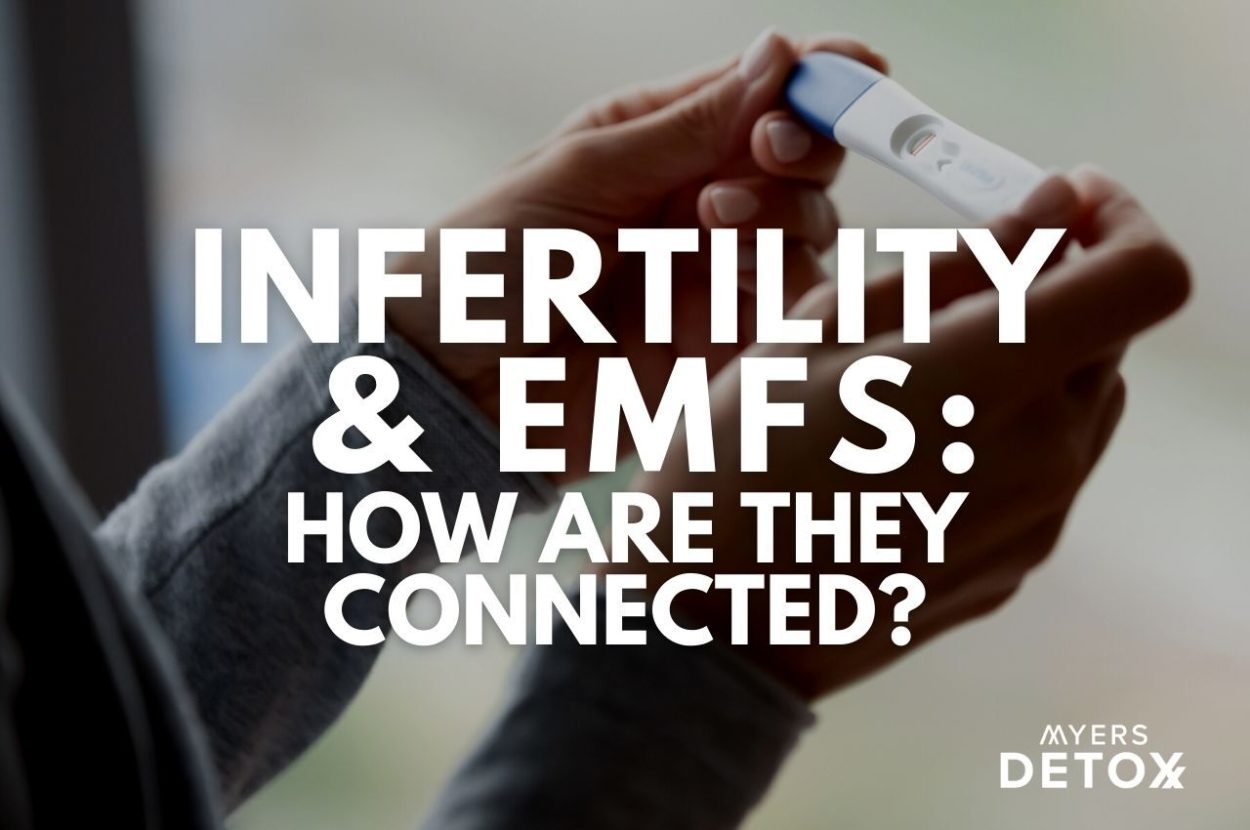Infertility affects approximately 10-15% of couples in the US, and research shows that infertility rates are rising each year[1]. While several factors can contribute to an inability to conceive, research shows that the rising trends in infertility may be related to the increased levels of EMFs in our environment.
In this article, you’ll learn:
- What fertility really is, and why it’s so important
- How EMFs can damage sperm and reproductive organs
- The impact of EMFs on female sex hormones
- How you can protect yourself against the devastating effects of EMFs
What Is Fertility and Why Is It Important?
In the most simple terms, fertility is the ability to conceive a child. However, from a physiological standpoint, being fertile means much more than getting pregnant – a fertile body is a healthy body.
Put another way, if your body is infertile, that means that something much deeper is out of balance that’s now allowing you to conceive. Often the issue is rooted in hormonal imbalances.
Of course, there is a window in a woman’s life where she is meant to be fertile, and when that window closes, it’s completely natural that her body would no longer be set up to conceive. In this case, the terms infertility wouldn’t necessarily apply. With that being said, if you are within the window where your body is fertile, then an inability to conceive is a red flag for deeper imbalances that shouldn’t be ignored.
The same holds true for men that are u able to conceive. Unless it is a functional issue, an inability to get a woman pregnant is often rooted in a deeper imbalance.
When we zoom out at the human body, your hormonal system works as an intricate and fascinating dance that requires balance and equilibrium. If sex hormones are at the root of infertility, then you can be sure that other hormonal systems are also off-balance, such as the thyroid and adrenals.
All of this to say, fertility is a sign of health. Infertility, on the other hand, is a sign of deeper imbalances.
The Impact Of EMFs On Fertility

Although there are several known factors that can contribute to infertility, EMFs are becoming one of the most well-researched contributors for both men and women.
Let’s take a look at what the research has to say regarding EMFs and the male and female reproductive systems.
EMFs and Infertility In Men
Thus far, research shows that the primary route for male infertility due to EMF exposure is due to oxidative damage to sperm induced by electromagnetic frequencies. EMFs can produce reactive oxygen species (ROS), which lead to oxidative stress and damage. This damage can directly impact the testes and sperm in men, resulting in less viable sperm[2].
Radiation from cell phones, laptops, WiFi, and microwave ovens are all common sources of EMFs that are impacting sperm quality and leading to issues with fertility.
In one study, researchers found that EMFs from mobile phones adversely affected the quality of semen by decreasing sperm count, motility, and viability[3].
Other research shows that oxidative stress and resulting reactive oxygen (ROS) species caused by EMFs can impact DNA, creating genotoxicity – genetic mutations that damage the cell[2].
Investigators warn t against keeping cell phones in the pocket due to the proximity of the testes and the high frequencies of cell phones[4]. With that being said, laptops, tablets, and any other handheld wireless device should also be kept at a distance when used regularly.
EMFs and Infertility In Women
Oxidative damage also plays a role in female infertility, but for the female reproductive system, there may be more routes for potential damage.
EMFs and Functional Damage
From a functional perspective, animal studies show that EMFs damage endometrial tissue, a layer of tissue lining the uterus. The endometrium plays a crucial role in menstruation and pregnancy as this is the tissue in which a fertilized egg will implant if conception takes place. During the menstrual cycle, the endometrial tissue becomes thicker to prepare for potential implantation. If implantation does not occur (there is no conception), the endometrial lining will break down, and you’ll get your period[5].
As you can imagine, damage to the endometrial tissue creates significant issues with fertility as this structure plays a vital role in the implantation process.
Other research shows that EMFs may accelerate the process of cell death and turnover in the ovaries. Your ovaries are the oval-shaped glands located on either side of our uterus where egg development takes place. When your ovaries are damaged or not functioning properly, the downstream result could lead to improper egg development[6].
EMFs and Hormonal Imbalances
Another way in which EMFs may impact the female reproductive system is by inciting hormonal imbalances. The female hormonal system is a tightly regulated machine that requires several hormones to work together in a sort of dance as they ebb and flow throughout the menstrual cycle. When hormones become imbalanced, it can make it much more challenging to conceive as it is the hormones that drive the functional structure and activity of the entire reproductive system.
Research shows that one of the hormones that EMFs can impact directly is melatonin. Melatonin is known as the sleep hormone because it plays a vital role in your circadian rhythm. At night melatonin naturally rises, signaling your body that it’s time to wind down and go to bed; during the day, melatonin stays low, which allows you to remain awake and alert[7].
In addition to managing your sleep-wake cycle, melatonin also helps to regulate your sex hormones. Specifically, luteinizing hormone (LH) and follicle-stimulating hormone (FSH). These two hormones stimulate the ovaries to produce a follicle, which contains an egg; they then go on to stimulate the release of an egg from the ovary. Furthermore, FSH and LH are also involved in the production of your gonadal sex hormones (estrogen and progesterone).
As you can see, all the hormones in your body work together to keep things running smoothly.
Unfortunately, this means that when EMF exposure suppresses melatonin production, all downstream processes become altered. Low melatonin will directly impact LH and FSH, which impacts egg production and further influences estrogen and progesterone synthesis[8].
All of these imbalances are a recipe for infertility[9].
How To Mitigate EMF Exposure

The research on EMFs and fertility may be a bit shocking, but the good news is that you don’t have to move to the middle of nowhere to protect yourself from these frequencies. EMFs are a growing concern as 5G, and other sources of these frequencies are continuing to roll out across our country. However, you can take steps that will mitigate the influence that EMFs have on your body.
Begin by reducing your everyday EMF exposure in ways that you can control. This could look like:
- Turning off your WiFi at night (or whenever you’re not using it). For extra credit, you could even get an ethernet cord.
- Unplugging and turning off devices in your bedroom while you sleep.
- Putting your phone on airplane mode as often as possible. Or, if you need to have it on, keep it in another room away from your body.
- Avoid carrying your phone on your body (in pockets).
- Using EMF-protection stickers and stones on your WiFi router, phone, computer, and any other Smart Device you have.
- Avoid wearable fitness trackers, and if you do, keep them on airplane mode as much as possible.
- Using wired (instead of wireless) office appliances like printers, computer mouse, and fax machines.
- Switching out your Smart Meter for a manual reader.
All of these tips will help to reduce the amount of EMFs you have streaming through your home and in your immediate environment.
However, making adjustments such as those above won’t do much for you if you live in a city where EMFs are streaming through every building or when you leave your home and go to a coffee shop, grocery store, mall, or any other public setting.
When you go out into the world, you need a wearable EMF-mitigation device that can help to neutralize the frequencies in your environment. My top choice for wearable EMF protection technology is the Harmoni Pendant. The Harmoni Pendant is a lightweight necklace that can travel with you wherever you go for all-day EMF mitigation.*
Unfortunately, in the world we live in today, there is just no way to know what type of frequencies are around, so keeping a simple wearable device on your body is the perfect fail-safe.
Takeaway
For couples that are trying to conceive, infertility can be incredibly emotionally and physically draining. While there are several factors that can come into play with fertility, it’s worth taking note of the rising trends in infertility that correlate with increased EMFs in the environment. Taking measures to reduce your EMF exposure should be one piece to your fertility plan.
With that being said, even those that aren’t trying to conceive will greatly benefit from reducing EMF exposure. Fertility isn’t just a marker of being able to get pregnant; it’s a sign of a healthy and well-functioning body.
*These statements have not been reviewed by the FDA. The Harmoni Pendant is not intended to diagnose, treat, cure, reverse, or prevent any disease. It is not intended to replace any other treatments, medication, or healing modalities that may be prescribed by your medical doctor.










